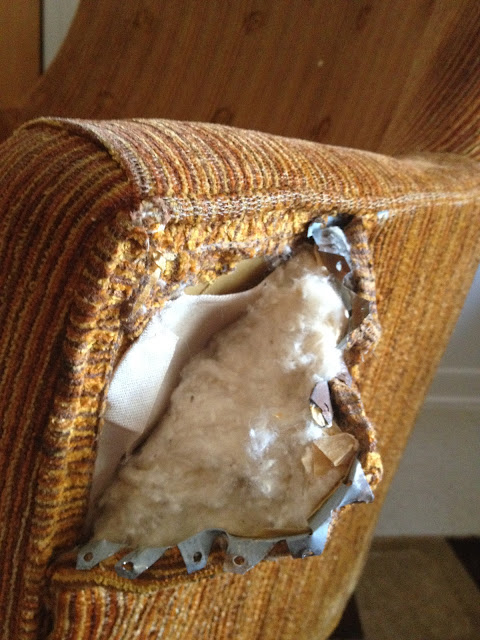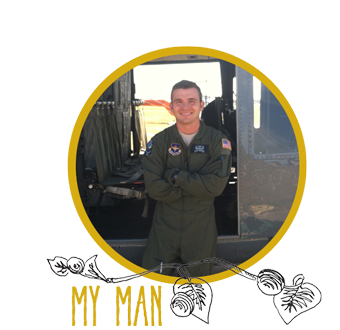Okay, the chair. I'm going to try to be step-by-step about this just so you learn from my mistakes, but I forgot to take pictures of some of the steps.
We found this when we were back in Texas eating at Sushi Cafe in Denton. Where you ask? That's right, a dumpster. This and that. Fo FREE! So of course we took them.
When we got back to Del Rio with our sweet A finds, I started shopping for fabric immediately. I looked online a little, but really had my sights set on a store in Abilene called Relics. They have the coolest furniture and TONS of fabric swatches so I decided to order from them. One regret I do have about the whole thing is not researching on the internet more before I bought fabric in-store. It gets really expensive really quick. So I bought fabric from the store, and when it came in, I just wasn't inspired by it for this chair. WASTE. So I looked on JoAnns fabric, and found a gem. Its been used before, but I loved it so I ordered it too.
Okay here we go.
Supplies:
Sewing Machine
Brains
Heavy-duty staple gun. (I didn't have a air-pressure shooter gun, so I had to use a manual staple gun. May the force be with you because I had blisters galore when I was finished stapling).
Pencil to outline the pattern with.
Sewing pins (I'm not sure of the technical name. Those needles with the balls on the end.)
Here's the chair starting off...and here's me being too serious in the background...creeper.
Basically I just started ripping everything off. There were a MILLION staples that had to come out. Take all of them out. Take all of the stuffing (batting) off and out. Basically you'll have a chair with just the bones. This was the most time consuming part of it all in my opinion. Next I had read on numerous internet sites that you're supposed to start backwards. So whatever you ripped off LAST is FIRST. And so I started with underneath the seat cushion. (Its a good place to start for those of us who have never done this before).
I don't know if you can see all the metal things. I don't know what the technical name for those are other than a pain in the ass to get out. Once you take off the old fabric, SAVE IT FOR THE PATTERN. Take out all the stitching. So pieces that were sewn together (the front and the back) take apart. So instead of one piece of fabric for the entire front, its broken up into three: left side, center, and right side. Trace all the patterns! Leave an inch or so on the outer edges, but on the sides that will be sewn, trace very close to the original, that way your new pattern is more accurate. What I did was pencil in the EXACT edge and leave an inch after that before I cut it. That way you know exactly where you should be sewing. On the inside of the chair (backrest and arms) I would leave a few extra inches around the outside edges, that way you have PLENTY of leeway to add more stuffing and do your tufting; still having enough fabric left to staple at the end.
This is before I took the canvas backing off and found a lot of old stuffing and moldy candy.
The orange is old batting. It literally fell apart in my hands when I touched it. So none of the stuffing was really salvageable (mo' money, mo' problems, you know what I'm sayin)? Above also I started taking off the canvas. I found all this random skinny rope and was like "ew what's this?" and the chair eventually revealed it was the string holding the tufted buttons.
This is after I ripped off the bottom part, the part under the cushion. You can kind of see the gross batting on the seat. Pull all of that off. Don't be scared like I was.
At last! after the chair was started. So I found an old sheet and decided that would be good for the "under-the-cushion" part. You apparently have to sew that and the fabric for the lower section of the chair together. That was a thorn in my side, let me tell you. I don't have pictures because honestly I was so frustrated that was the LAST thing I wanted to be doing. I also thought at this point "what have I gotten myself into"? ...It's completely normal. Soldier on! All I remember is having to make cuts at the corners and sew. It wasn't pretty. But I did it somehow. Sorry no step-by-step for that. As for tucking the sheet material and securing it, TUCK AND PULL AND PULL AND PULL and staple. Leave PLENTY of extra fabric for that area. You'll probably need it. And you can just cut it off once you secure it with staples.
Okay I finally attached the bottom part. It took me like a day. Okay just kidding...but it took like 6 hours because I wasn't sure what I was doing. And mistake numero uno: I didn't leave enough sheet to tuck and pull in the back! So I had to stick my stapler up the most random parts to secure it. Next:
I reused the old piping. Its really just rope but I felt like I had already dropped a milli on this chair so I wanted to conserve what I had. So I just cut the stitching and started pulling the fabric apart so I could just pull the rope out.
Like so. I Just pulled and kept pulling until it came out. And yes I'm still in my pajamas. It was probably 4 o'clock or something. Who cares. So once I got the rope out, I just laid it on the fabric, cut a strip about 1/2 inch longer on each side. Then I folded the fabric and pinned it. Then finally I sewed it...viola! The piping finished.
Next I just stapled the piping along the outer edges of the chair. Starting at the bottom and going all the way around
Okay so after the arm, I had some trouble. It was really difficult for me to match the old pattern of the front precisely (aka I left an inch extra on EVERY side, instead of just the outer edges, so my 3 pieces were off center and it was annoying). So I had to kind of just guess and check. BLAH! Just continue to do what you did on the arm once you line everything up. just staple along the back, then stuff the batting under the fabric to your satisfaction....then before you tuck and pull and staple, let's secure the buttons:
If you have tufting to do, DO THAT BEFORE YOU TUCK AND STAPLE THE FRONT AND SIDES PATTERNS. This is the ONE thing I wish I would've done differently. It would make such a difference. I actually contemplate redoing the entire chair just for the tufting.
SO to tuft:
I bought these buttons at Wal-Mart for like 2 bones each. They have the "maker" in it too. Basically you just push the fabric in and fasten the back to it. Here's where I would recommend some super glue to secure the backing on. (I didn't and like all of them popped off when I was securing them. Annoying).
After you've made the buttons, get some rope or something to fasten the buttons through the front of the chair to the back and staple them tight. I ended up using a needle to poke through the front and pull to the back. Then once I pulled to my satisfaction, I stapled the rope to the bones of the chair. Since you haven't pulled and stapled the front or sides yet it should look real nice and fluffy as you tighten and pull and staple the button. (Mine looks a little stiff). I don't have a picture of this! Sorry.
But this is kinda what it looked like from the back at this point. You can see the extra fabric, batting and also the piping!
Okay here's another difficult part: The backside. Like I said before, you should have each pattern of the original fabric to be your guide, so leave an inch or so extra along the OUTER EDGES, and next to none on the edges that will be sewn. Once you've sewn the pieces together to make the back of the chair, we start the difficult part. I used cardboard because it was free and flexible enough. The cardboard is the guide to your straight edge along the backside (as you can see below). So just staple and staple. I personally didn't see the point of putting batting on the backside, so I didn't.
The tough part for me was stopping every once in a while to make sure your pattern aligned nicely with the chair. Keep tucking the fabric over the cardboard and stapling. It's going to get more difficult to staple as you go...and I wish I had a solution for it, but I don't..and I couldn't find one on any of the tutorials I used. I would staple the entire top along the chair before I started stapling the bottom. Hopefully that will make it easier for you. (I stapled top and bottom evenly as I went).
Here's the chair with all the fabric tucked and stapled. I hadn't stapled the back at this point because there are no buttons. So the pictures are a little out of order, but I wanted you to see the almost finished project.
Okay its downhill from here. All we have left is the cushion! I just used the existing cushion (no need to make a new one). I made the pattern off of the old one! This will be the easiest part to sew because you can leave an inch all the way around. The only tricky part (for my chair) was that the cushion wasn't exactly symmetrical, so it mattered which piece of fabric was for what side. Make sense? So before cutting just make sure that you trace around the top of the old fabric for the top of the new fabric and vise versa for the bottom (I would keep them separate, too). This way when you finish the cushion fits just right. Another mistake I made: didn't pay attention to what was top and bottom. So my cushion doesn't fit in the sleeve exactly like it should.
So pay attention!
Next, we are going to sew our piping to the cushion pieces. This tutorial was great for the cushion. It will help you too! I found it was easiest to line the edge of the piping up with my pencil marking (for the outline of the cushion) that way the piping on the cushion is nice and tight where it's supposed to be!
It also doesn't hurt to iron, or in my case use scissors and create a crease (lazy) along the pencil marking to make it easier to sew. The first picture is creasing before I pinned the piping to it. The second and third are pinning the piping.
Almost finished! So once you finish the piping, you have your top piece! Then just do the same thing for the bottom piece! The last step is the middle-part in between the top and bottom of the cushion. Obviously I don't know the name of this. Again, use the original fabric for your pattern. I just measured the width of the old and made a strip of new fabric the same width (plus 1/4 inch for sewing). The corners are tough, so I would definitely cut them to minimize the fabric sewn (check this blog for how to cut the corners).
Guess what? We're finished! Put that in your bank. (I think that's a saying)? And the finished product:
(Oh, I plan on painting the legs, I just haven't gotten around to it.).
Had to get one with the girls on it, duh.
Next up in the tutorial secsh: a dining room table!!





































You are awesome! You really should do this on the side.
ReplyDeleteI LOVE THE CHAIR!!! I have been in the process of doing a chair, but it's going SLOW! It's so old, the staples are so hard to get out! But I can't wait to have a beautiful chair like this! GREAT JOB! (and cute dogs)
ReplyDeleteThanks so much Brittany!! It is hard but worth it! I can't wait to see yours :)
ReplyDelete